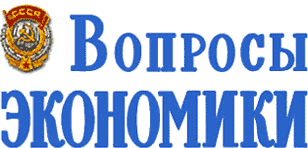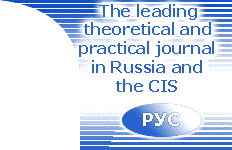|
RUSSIA IN THE WORLD ECONOMY
|
|
|
|
__________________
|
EXCHANGE RATE: PROBLEMS OF MODELING
|
|
INTERNATIONAL FINANCES |
|
|
REFORMS, THEORY AND EDUCATION |
|
IN AID TO THE LECTURER
|
|
CRITIQUE AND BIBLIOGRAPHY
|
- The World on the Border-line of Millenniums (The World Economy Development Forecast till the Year 2015). Eds. V.A. Martynov, A.A. Dynkin
- Ryvkina R.V. The Drama of Changes
- Ziyadullaev N.S. The CIS: The Way to the 3rd Millennium (Problems of Development and Perspectives of the Commonwealth Consolidation)
Abstracts
|
|
A. KLEPACH, S. SMIRNOV, S. PUKHOV, D. IBRAGIMOVA.
Russia's Economic Growth: Ambitions and Actual Prospects
|
|
The article discusses the subject of defining Russia's position in the global economy as soon as the period of transformation is over. Factors responsible for GDP rates of growth calculated at purchasing power parity are arranged in a system. Issues of economic policies for encouraging economic growth and catching up with West-European level are analyzed.

|
|
S. MITSEK.
Should Russia Beware of Globalization?
|
|
Benefits of globalization and problems it is creating for different countries are considered in the article. The author analyzes strong and weak positions of Russia as a member of global economic processes and formulates a few proposals about its integration in the world market.

|
|
P. KADOCHNIKOV, S.SINEL'NIKOV-MURYLEV, I. TRUNIN.
|
|
The authors use econometric estimates on the panel data for Russian regions in 1994-2000 to empirically analyze the federal aid distribution formula. This includes its estimates as well as the tests of the differences in the formula parameters for poor and northern regions. In addition the paper includes tests of the fiscal incentives of the regional authorities that arise with the aid distribution, that is how the federal financial aid influences the regional budget revenues and expenditures.

|
|
B. ALEKHIN.
The Foreign Exchange Market and Microstructure Finance
|
|
Market microstructure theory is unknown in Russia. This article invites Russian economists to examine terra incognito by pointing to a growing interaction between exchange rate economics and microstructure finance. It firstly describes various approaches to exchange rate determination and then reviews recent progress in applying market microstructure tools to exchange rate puzzles. The article concludes with a small survey of microstructure of the Moscow Interbank Currency Exchange.

|
|
N. BOCHAROVA.
Modeling of Optimal Exchange Rate
|
|
The question of how to choose the appropriate value of the nominal exchange rate has remained a key concern of macroeconomic policy in transition economies. Basing on the critical analysis of current Russian policy the author suggests one of the models of estimating the appropriate value of the exchange rate for policymakers. The author proposes to estimate a target function of the central bank which is a market-maker in the fixed exchange rate arrangements. This function reflects the relationship between actual real exchange rate misalignment from its equilibrium value and change of GDP, government budget income and inflation, unwillingness to have real appreciation (and thus lose competitiveness of export) and the cost of changing exchange rate arrangements.

|
|
A. SARKISYANTS.
Financial Crises and Sovereign Debt Problem
|
|
The article is devoted to the problems of international state indebtedness and their influence on world financial crises. It considers recent new approaches of the realization of the sovereign debt restructuring mechanism. Special attention is paid to the position of the Russian Federation in these issues.

|
|
I. KOVZANADZE.
System Banking Crises in Conditions of Financial
Globalization
|
|
Methodological problems of Russia’s involving into international division of labor are considered in the article. The authors state that estimation of macroeconomic efficiency can serve as a major tool of state regulation of foreign economic relations. They point out that before Russia’s WTO accession the efficiency of most export-import transactions must be calculated.

|
|
V. MEKHRYAKOV.
Development of the Banking Services Market
after Russia's WTO Accession
|
|
The article deals with the problems that can arise before the national banking system after Russia's WTO accession. The repercussions of banking sector liberalization on the WTO conditions for the national economy are shown on the example of Poland. The author brings forward the priorities of banking industry development, the analysis of specific commitments and their comparison with national strategic interests.

|
|
S. SHENDEROVA.
Problems of Teaching Economic Disciplines
in Technical and Natural Institutes
|
|
The article deals with problems of economic education in technical and natural sciences universities such as imperfect government regulation in this field and the reasons of its inefficient organization at the university level. As the basis for investigating the efficiency of instruction in economic subjects estimation criteria are proposed. The ways of increasing efficiency in economic education on both federal and university levels are considered. Some recommendations about organizing courses of interdisciplinary training for lecturers of economic subjects are given.

|
|
A. VIFLEEMSKY.
The Role of the Educational Complex
in Post-industrial Society
|
|
Socioeconomic nature of the sphere of education as a single polifunctional complex is investigated. Under conditions of qualitative transformations in the system of social production expenditures on educational complex are investments in the country's intellectual potential.

|
|
R. NUREEV.
Public Choice Theory. A Textbook.
Chapter 1. Public Choice: Methodological and Theoretical
Prerequisites of Analysis
|
|
The object of analysis and methodological prerequisites of public choice theory are considered in the first chapter of the textbook. Special attention is given to new institutionalism and rational choice theory. The role of J. Buchanan in creation of new political economy is pointed out. The structure of the theory and the specifics of empirical analysis are presented. The chapter includes bibliography and web-resources list which are related to the whole course.

|



